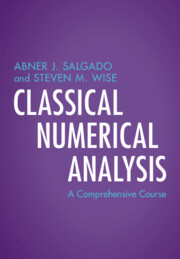Book contents
- Frontmatter
- Contents
- Preface
- Acknowledgements
- Symbols
- Part I Numerical Linear Algebra
- Part II Constructive Approximation Theory
- Part III Nonlinear Equations and Optimization
- 15 Solution of Nonlinear Equations
- 16 Convex Optimization
- Part IV Initial Value Problems for Ordinary Differential Equations
- Part V Boundary and Initial Boundary Value Problems
- Appendix A Linear Algebra Review
- Appendix B Basic Analysis Review
- Appendix C Banach Fixed Point Theorem
- Appendix D A (Petting) Zoo of Function Spaces
- References
- Index
15 - Solution of Nonlinear Equations
from Part III - Nonlinear Equations and Optimization
Published online by Cambridge University Press: 29 September 2022
- Frontmatter
- Contents
- Preface
- Acknowledgements
- Symbols
- Part I Numerical Linear Algebra
- Part II Constructive Approximation Theory
- Part III Nonlinear Equations and Optimization
- 15 Solution of Nonlinear Equations
- 16 Convex Optimization
- Part IV Initial Value Problems for Ordinary Differential Equations
- Part V Boundary and Initial Boundary Value Problems
- Appendix A Linear Algebra Review
- Appendix B Basic Analysis Review
- Appendix C Banach Fixed Point Theorem
- Appendix D A (Petting) Zoo of Function Spaces
- References
- Index
Summary
This chpater is dedicated to the solution of nonlinear systems of equations, that is finding roots of functions. We begin with a classification of roots into simple and non-simple, and a few words about their stability. Then we begin with some of the simplest methods for root finding: bisection, false position, fixed point iterations, and its variants. For all these schemes, we provide sufficient conditions for them to be well defined and convergent. A detailed analysis of Newton’s method, and its variants (collectively known as quasi-Newton methods), in one dimension is then presented. We show sufficient conditions for its local and global quadratic convergence,as well as how to proceed in the case of non simple roots. Then we present Newton’s method in several dimensions, and show its local quadratic convergence, including the celebrated Kantorovich’s theorem.
Keywords
- Type
- Chapter
- Information
- Classical Numerical AnalysisA Comprehensive Course, pp. 419 - 450Publisher: Cambridge University PressPrint publication year: 2022

